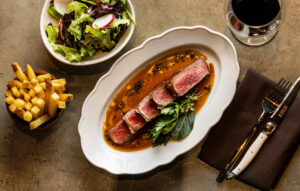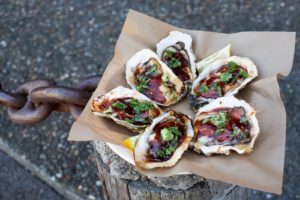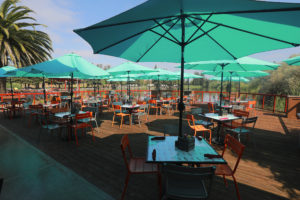On a recent night in Petaluma, inside a tiny restaurant on the outskirts of downtown, the first bites of a tasting menu arrive, each an elegant, flavorful surprise: Jet-black squid-ink madeleines topped with caviar and gold leaf, a delicate taste of the sea. Silky beef tartare in a crisply fried wonton shell. A frothy cup of asparagus cappuccino.
Here at Table Culture Provisions, the menu channels its owners’ talent and skill—but also their fundamental optimism. It’s a rough time to have a high-end restaurant. Rising costs and staff burnout plague the industry, and profit margins for fine dining are slim.
But Table Culture Provisions holds its own as part of a growing movement to pivot away from toxic perfectionism, 16-hour workdays, and costs soaring out of control. Chefs and business partners Stéphane Saint Louis and Steven Vargas have learned how to serve fine dining’s most rarified form—the tasting menu—while keeping their sanity intact, their budgets lean, and their hearts warm and generous.

The Launch of a Dream
Vargas and Saint Louis have been scrappy from the start. Stéphane Saint Louis, a tall, confident man with a kind yet intense gaze, grew up in Haiti, where food and family set the weekend rhythm.
“On Saturday mornings, the puff pastry vendor would drop half a dozen at our door,” he remembers. “Sunday was all about church and stopping at friends’ houses for dinner.”
Saint Louis moved to Marin County at 17. When he got interested in cooking, one of his aunts cosigned the loan for culinary school at the California Culinary Academy in San Francisco. Later, another aunt paid his way at the renowned Institut Paul Bocuse in Lyon, France. (“Aunties are clutch,” he says.) After internships, Saint Louis returned to California in 2017 to lead a new dinner program at Petaluma’s Della Fattoria, where he met his future business partner.
Steven Vargas, born and raised in Petaluma, was a chubby-cheeked, soft-spoken apprentice fresh out of culinary school at Santa Rosa Junior College. As a kid, he’d spent summers with his grandmother in Acapulco.
“I’d catch the chickens in her backyard and she’d slingshot iguanas for tacos, my favorite,” says Vargas. “She’d have the entire family, 20-plus people, for dinner on the weekends.”
At Della Fattoria, Vargas was on fire, Saint Louis says. “Apprentice? There was no apprentice. He was picking up most of the work, and he excelled at it. For any task, you knew you could depend on him.” Plus, Vargas had an excellent, semi-ironic tattoo on his right arm: the Grim Reaper clutching a cup of coffee above the words “No Days Off.”
Vargas, for his part, was inspired by Saint Louis. “The furthest east I’d been was Texas. I was captivated by his experience.”
Saint Louis had a tattoo of his own, a Michelin star, reminding him always of the standards he held high. In March 2020, as the world turned upside down, the friends found themselves at a turning point.
“Pandemic or no pandemic, as long as people exist, they gotta eat,” says Saint Louis. “We said, we can go home and collect unemployment, or we can take advantage of the situation and make people feel better in these hard times by offering a good meal.”

They started a fried-chicken takeout pop-up at The Shuckery. Then, in a now-legendary move, the two invested their pandemic-era federal stimulus checks, totaling $2,700, in Tesla stock. Within a few months, the investment was worth $17,000—enough for a down payment on a catering truck.
They used the revenue from selling fried chicken to stay afloat, later moving to a semipermanent home in Petaluma at Wishbone restaurant. Along with the move came a new name: Table Culture Provisions—a nod to their diverse backgrounds, and one that seemed broad enough to hold space for all their ideas, including, someday they hoped, their own restaurant.
Table Culture Provisions took off, going from one night a week to two, with brunch on the weekends. Saint Louis and Vargas served global comfort food like cassoulet, trout en croute, even a multicourse Haitian feast featuring braised oxtail and rum cake with proceeds going to help fund a school in Haiti.
After securing additional financing from a local supporter, they were ready to look for a permanent home. The spot they settled on seemed improbable at first—a former chili joint with only seven tables— but the kitchen was functional, and the price was right: $150,000.
“We were so desperate, and we were so into it,” remembers Saint Louis. “We decided to make it work.”
Down to their last $1,000, they needed to open the restaurant as soon as possible. They had the walls painted a deep slate blue, enclosed the kitchen, and added a long window into the dining room. Two weeks later, in December 2021, they launched.
Right away, they were doing 40 to 50 covers a night, with an à la carte menu and brunch on Sundays—and almost right away, they realized their concept was losing money. With checks topping out at about $60 a person and room for so few customers, they couldn’t cover costs.
“Our bookkeeper told us we wouldn’t last another couple of months,” says Saint Louis. “But in a way, we’re richer when we’re more broke. It forces us to innovate.”
So he and Vargas and their newly hired team, working “like a bunch of madmen,” introduced a higher-priced tasting menu alongside the à la carte one, and found that customers preferred it. They tinkered with various tasting menu lengths and prices to find out which would resonate most, sometimes cranking out three or four menus at once—which made service “complicated,” to put it mildly.
Two and a half years later, they’ve dialed in the options. The à la carte menu has morphed into a “Social Hour” twice a week. They’ve got a side hustle supplying breakfast pastries and sandwiches for a nearby coffee shop. They’re offering four-course and seven-course tasting menus four nights a week, trimming a crew of 11 cooks and servers to seven. And they have a sommelier, Robert London, a wine importer, early customer, and immediate fan.
“We’ve been like starving artists,” says Saint Louis, laughing. “We’re by no means in a comfortable spot, but at the same time, we’re always aiming for more.”

What It Takes
Table Culture Provisions is a story of ambitious food on the leanest of budgets, and of building camaraderie and community. While shows and movies like “The Bear” and “Boiling Point” give the picture of fine-dining kitchens as near-intolerable pressure cookers, with chefs melting down under the strain, the mood in the tiny kitchen remains measured and respectful.
The workspace is just 400 square feet, packed neatly with countertops, sinks, a stovetop, and ovens. To pass someone in the narrow central walkway, you have to turn sideways. There are only three chefs for dinner service—Saint Louis on the hot station, Vargas expediting tickets and assembling plates, and French pastry chef Sylvain Parsy.
Although each chef has a focus for the night, everyone helps out with everything—and Saint Louis and Vargas will sometimes swap places for the night, just for fun. Each does all his own prep, saving the cost of a traditional kitchen brigade with its specialized roles. They wash their own prep dishes and scrub down the kitchen at the end of service as a team.
“We never have a problem with that,” says Saint Louis, swiftly cutting steak into tiny dice for the beef tartare. “That mentality helps us keep a healthy workplace. We don’t expect the lowest guy to do it. We’ll get down and get things done, together.”
All the cooking is driven by what’s in season locally. Much of their produce comes from Asombrosa, a farm on 63 lush, hilly acres outside town.
“We change the menu every six to eight weeks,” says Saint Louis. “Our farmer sends us updates, and we plan around availability. How many pounds of peas are there, and how long will we have them? Then: How do we treat the peas—do we blanch and pair them with halibut, or do a cold pea shooter with mint oil? Are there pea flowers, for garnish?”
Together, the three chefs start charting the new menu, bouncing ideas around as they’re cooking. “We set our hearts on the techniques, and then we go for it,” says Saint Louis. “Then, once the menu starts, the ideas become more clear. By the second week, we’re mastering it, finding ways to streamline or amplify, hitting the sweet spot.”

Every bit of food gets used. Spring asparagus, for example: Saint Louis sears the dark-green tips to pair with black cod. The ends go into the asparagus cappuccino and the arancini, or fried rice balls. Beef trim, left from braising beef cheeks for ravioli, becomes the base of the velvety sauce on that pasta.
These chefs prep their food as if they were jewelers, crafting each exquisite component with care. Saint Louis drapes a gougère with a wafer-thin circlet of buttery, salty-sweet nori seaweed dough, then slides a panful of the savory puffs into the oven.
“The weight of the flour and butter keeps the gougère’s shape intact,” he explains. “It also gives the pastry a crackly, crisp texture.”
Creating a leek garnish takes no less than seven steps. Vargas slivers fresh leeks, blanches them in boiling water, plunges them in ice water to set the color, and dries them out in a dehydrator. “No coating. We want them to stay very green.”
Using chopsticks, he culls any thick, ungraceful strands. Then he fries the leek threads, agitating them constantly to prevent clumping or browning. He fries them a second time, to get them ultra-crisp. Finally, the leeks become glistening, crunchy tumbleweeds of flavor, ready for the fish course.
The chefs are always looking for ways to improve techniques, make them more efficient. Instead of individually baking the wonton pastry shells with pie weights in the classic manner, they just stack the raw wontons in their fluted metal tins and deep-fry the entire stack at once. The wontons emerge perfectly pleated, crisp and golden.
“Paul Bocuse is probably turning in his grave right now,” says Saint Louis. “But the point is the end result, and this works better.”

A Record Player in the Kitchen
At the pastry station, tucked into the far corner, Sylvain Parsy sets a pear and milk-chocolate tartlet on a turntable—an actual 45 rpm record player he bought for the purpose—and gets it spinning. Bending in close, hands steady, he pipes on Chantilly cream, wrapping the top of the tart in a perfect ivory spiral.
“I had to do 50 of these before I got the hang of it,” he admits. For the final touch, he dips a skewered hazelnut into molten sugar, and then suspends it from a shelf until the dripping caramel forms a delicate candy spear: “One of our waiters calls this the Hazelnut Meteor.”
Any of the restaurant’s tasting menus has dozens and dozens of these components, requiring fierce attention and skill. “Our small scale saves us,” Vargas says. “If we were larger, the labor and time would cost us too much.”
Despite the intensity of the work, the mood isn’t somber. There’s plenty of joking and teasing going on, especially around the fantasy basketball league they’ve started.
“I saw your trades last night, late,” Saint Louis says to Parsy. “Why weren’t you sleeping? You’re not panicking, are you?”
Family stops by, too. Marta, Saint Louis’s wife and the restaurant’s bookkeeper, often pops in with one of their two young children in tow. Not surprisingly for a chef’s kid, Saint Louis’s 6-year-old will taste anything—and deliver a thumbs-up or a thumbs-down.
Those visits help Saint Louis maintain balance in his life. Living close to work—he and Vargas both have houses just down the block—helps too, saving commuting time. They both take Sundays off, Saint Louis for family outings, Vargas to explore local restaurants and wineries.
“Sometimes I’ll sneak into the restaurant and just be here alone, to collect my thoughts,” says Vargas.
“For me, it’s a lifestyle,” says Saint Louis. “I enjoy this. I never wake up and think, ‘Oh, I have to go to work.’”
On the days the restaurant is open, the chefs arrive by 11, ready to crank. Well before service starts at 5 p.m., each chef has his components and garnishes finished and backup food stowed in undercounter fridges.
Yulia Quintas, a dishwasher so fast Saint Louis calls her “the little machine,” arrives and starts darting through the kitchen, restocking dishes, running to the back storeroom, doing whatever anyone needs. She’s a pure burst of joy, smiling and saying hello, even though she’s come straight from another restaurant job to make ends meet.

Time for Service
So much of Table Culture’s food must be completed to order, or its appeal will fade. Pastry shells must be filled, tiny flowers tweezed on, sauces drizzled, and powders sprinkled, cleverly, from a tea ball. That makes time management even more crucial than in a typical restaurant.
Vargas works the tickets, noting when each course is set in motion, but the trio of chefs rely on the servers to track the pace of each table. “The kitchen window lets us see the tables for ourselves, too,” says Vargas.
There’s only one timer in the kitchen, and that’s for fresh pasta: two minutes exactly. The rest of the hot dishes—fried scallops, the steamed fish, and the sauces, finished with butter and cream—all rely on Saint Louis and his internal clock.
As the orders swell, everything starts to speed up, turning the kitchen into a river of motion. Miraculously, no one collides, and it’s almost totally silent.
“We don’t need to talk,” says Saint Louis. “We all know the stations, and we anticipate each other’s needs.”
Parsy whips down the line to help Vargas with the crab salad bites, stuffing the shreds into crisp Indian-style puris. Saint Louis whirls between counter and stove, flinging butter into pots of sauce, blanching turnips, searing asparagus on the flattop, swirling ravioli into its sauce. The hot steel doors of oven and dishwasher flap down, up, down, timed to the movements of the cooks. Meanwhile, the three servers whip in and out, dropping dirty dishes, picking up orders, drying freshly washed silverware. It’s hectic, but not crazy. No one yells.
What Saint Louis appreciates most is being part of this Sonoma community. “We send out respect and thoughtfulness, and they’ve supported us all along, bringing new customers to us, too,” he says.
Vargas agrees. “We’ve heard that our restaurant is a great first step for a lot of people who’ve never experienced fine dining before. They’ll say, ‘It’s so warm here. Now I can go other places and know it won’t be intimidating.’”
The two dream big, with future plans bubbling on the burners. If all goes well, they’ll be opening another restaurant this fall—and judging from how their food has been received so far, chances are good their fans will show up hungry.
Near the end of the night, a customer comes into the kitchen. She’s been celebrating her birthday tonight, and her face is glowing. “To be a Petaluman and have this food,” she says, putting her hand on her heart. “I’m so proud.”
Table Culture Provisions, 312 Petaluma Blvd. S., Petaluma, 707-559-5739, tcprovision.com



















